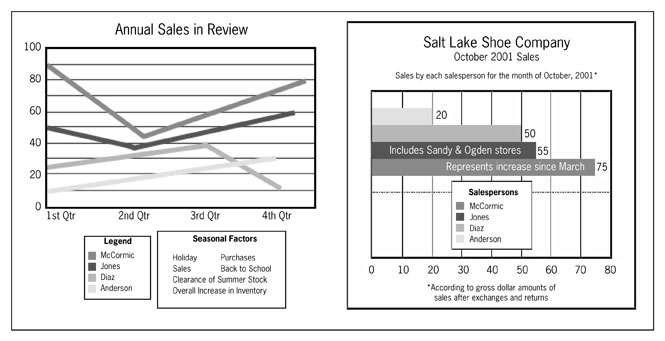Lesson 6: Informative Public SpeakingVisual AidsA good visual aid promotes your speech and clarifies your content. It must be visually aesthetic, simple, brief, and easy to see and read. It must support, but not dominate, your speech. A visual aid is not for the speaker to hide behind. It is only there to assist in sharing information with your audience. Look at the following examples of visual aids. One is obviously superior to the other for use in a speech. The other is crowded, cramped, full of trivial and minor details, and far too difficult for an audience to digest. 
A visual aid is an important medium in your presentation, so it is tremendously important for you to feel comfortable and prepared when using visual aids. Be sure to check your room, your equipment, and your visual aid materials in advance. Below is an example of what can happen if you are not prepared. As you are giving your presentation, you move the overhead projector into its proper position and proceed to turn on the light. To your dismay, the bulb is burned out. At this point you have lost your confidence as you hurry and apologize for the delay and say, “I‘m sorry, I will now move on to the next part of my speech. Since I am unable to use my overheads, let’s move on to my other visual aids. I have three very important posters to show you, which contain graphs and charts that are pertinent to my presentation.” You now look around the room. There is no easel. Since you also forgot to bring tape, you now try to lean the flimsy posters against the chalkboard, and they proceed to fall to the ground. You bend over, pick them up, apologizing with shortness of breath and asking if anyone in the audience has any tape. Does this sound familiar? I have unfortunately seen this over and over again. Please be prepared by checking the equipment (TV, VCR, overhead, cassette player, slide projector, and computer-aided projection machines). Check the temperature of the room. Is it extremely hot or miserably cold? Is there anything you can do to make the room more audience friendly? Have you mounted your posters on a poster board that will support them? Have you brought tape, thumbtacks, chalk, erasers, or an easel, or have you prearranged to have the room ready for you? You must foresee any unfortunate situation that might arise and prepare for the worst. If visual aids don’t work, I can guarantee your speech presentation won’t work due to your loss of confidence and momentum. In any presentation, it is important that the presenter is prepared, focused, and ready to connect with the audience. In this lesson we have discussed what to do and what not to do. It is up to you as the student to take responsibility in being ready to present. Create the need and the desire to know a topic and assist your audience in understanding, remembering, and applying. These lessons are not magic and will not make you a great public speaker overnight. They are steps to assist you in preparation for connecting with your audience. Speaking to inform happens every day of your life. Yet it is a difficult task that requires a lot of skill, because you have to convey knowledge to your audience. Please make note of two very important points about informative speeches:
|
About Us | Terms of Use | Contact Us | Partner with Us | Press Release | Sitemap | Disclaimer | Privacy Policy
©1999-2011 OpenLearningWorld . com - All Rights Reserved